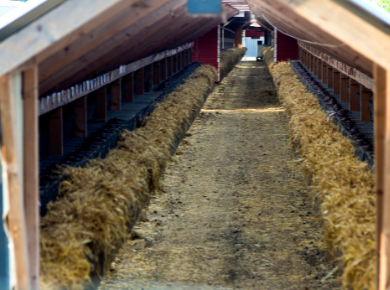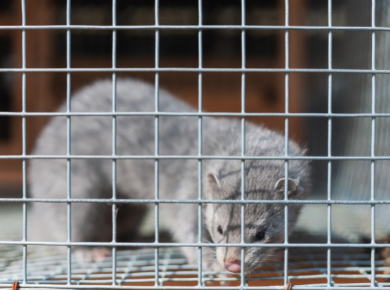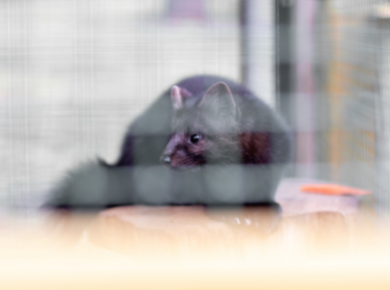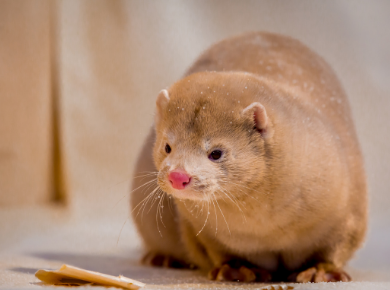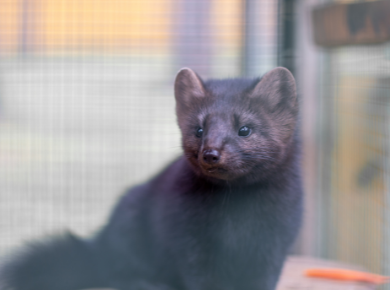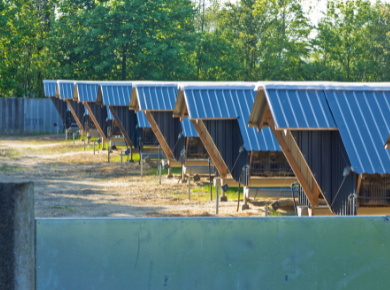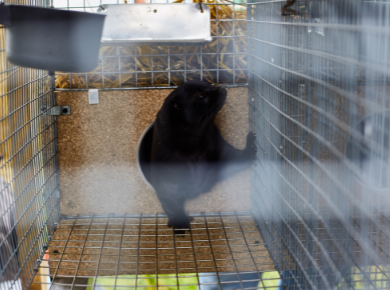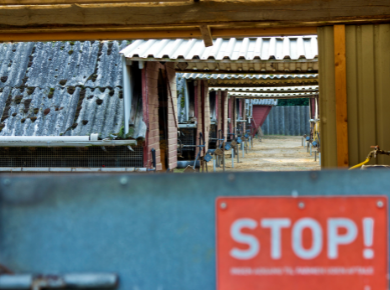Fur Farming
How Fur is Farmed
The majority of pelts used in the world fur trade now come from farms.
Over 40 million mink and fox pelts alone are produced each year, which is roughly equivalent to the total number of furs taken from the wild. In addition, Chinchilla, fitch, finnraccon, nutria and other furbearers are also raised in smaller numbers. Finally, large numbers of pelts are produced in some countries from sheep, goat and rabbits, where the fur is a valuable by-product of meat production.
Mink and fox are raised in the United States and Canada, the Soviet Union, the Scandinavian countries and throughout Europe - and even, increasingly, in Mainland China.
The farming of mink and fox began in North America almost one hundred years ago. From these pioneering efforts, close to six million pelts are now produced annually on some 4,000 family-operated farms.
Fur farms make efficient use of available resources in many regions of North America where soil is poor or climate too severe to support most other agricultural activities.
Raising fur animals also complements other farming enterprises. It demands the most from a farmer during the winter months when field crops require less attention. Straw is used for bedding and to insulate cages, while the manure from ranched animals returns to the soil as fertilizer. Finally, the meat by-product of fur farming provides animal feeds, bonemeal and other products. Mink oil is used to produce hypo-allergic soaps, cosmetics and fine leather preservatives.
In all, fur farming is an integral component in North America's diversified agricultural economy, making a $250 million contribution to the economy, while providing needed income for thousands of farm families.
No. Mink and foxes have been raised on farms in North America since the turn of the century. They have been selectively bred for more than eighty generations for such characteristics as fur quality and color, but also for lameness, ease-of-handling and other traits. This is the same way our important breeds of cattle, poultry and other domestic livestock were developed.
Farmed mink, notably, are considerably larger and have somewhat higher reproductive rates than their wild cousins. Needless to say, there are also important environmental influences which distinguish them from animals in the wild: day-to-day contact with the farmer who feeds them and the elimination of parasites, disease and predators.
As any pet owner knows, the condition of the fur is one of the clearest indications of whether an animal is healthy and well cared-for. Since the livelihood of the professional fur farmer depends upon producing top-quality fur, if for no other reason, the welfare of his animals is of prime importance.
Gunnar Krantz, Chairman of the Swedish Federation of Animal Protection Societies, has written:
Only a person who is interested in animals and who likes them becomes a fur farmer. Working with furbearing animals is no easy job; they are live animals and must be cared for and fed every day - weekday, weekend or public holiday. The farmer who has no real interest in his animals or feeling for their welfare soon suffers himself, in the form of poor financial return . . .
Dr. Bruce Hunter, of the Ontario Veterinary College, University of Guelph, has stated:
With the aid of new Codes and Practice, developed in cooperation with animal-welfare association, and through efficient rancher education programs, mink breeders are continuously up-grading the quality of mink husbandry and improving the health, genetics and nutritional standards of the industry. As with all animal husbandry, there is a need for continued research but, in general, mink are presently being raised in as progressive and humane a fashion as any other agriculturally-raised animal species.
Like any other livestock operation, fur farmers receive information and assistance from licensed veterinarians and agricultural extension officers, as well as from their own professional associations.
In addition, the national fur breeders' association, with the assistance of government and animal-welfare authorities, have now developed comprehensive Codes of Practice in all major producing countries.
These Codes set out industry standards for nutrition and housing, veterinary care and humane harvesting methods. The standards are administered by the Fur Farm Animal Welfare Coalition, in the United States, and by the Canada Mink Breeders and Canada Fox Breeders Associations.
The national associations have joined together to establish the International Welfare Organization for Fur Farm Animals. This group coordinates internationally accepted standards, as well as assisting member associations to monitor farms in their own jurisdictions.
Scientific research on nutrition and animal diseases, and modern veterinary care, have significantly improved the health and quality of farmed furbearers over the years. The fur trade now supports advanced "ethological" research, to determine how housing designs and other factors influence the well-being of farmed mink and foxes.
In Denmark, at the National Institute of Animal Science, a three-year study has been initiated to identify new designs for cages and nesting boxes. Similar projects are underway in universities and research centers in Finland and Norway, and in the United States.
In the early days of mink and fox farming, the animals were first raised in large pens on the ground. It was found to be difficult to keep animals free from worms and other harmful parasites in such conditions. The introduction of raised cages (which allow wastes to fall through) resulted in a dramatic reduction of disease, especially among young animals, and has been a major factor in improving the health and well-being of farmed furbearers.
Absolutely not. The claws of older foxes, however, may have to be maintained if they don't wear them down sufficiently. Vets do the same thing for many dogs.
Cages for both foxes and mink were once much larger. Scientific studies and practical experience have led to the sizes currently used. Tests with mink have shown that neither a 400% increase nor a 50% reduction in cage size cause any change in behavior. Cage design, including access to nesting boxes, appears to be far more important, and research is now being done to identify areas where further improvements might be made.
Mink and fox cages are placed in covered sheds which protect the animals from sun, rain and snow. Additional protection from wind and cold is provided by nesting boxes and, for foxes, by shelter shelves. These are especially important if the sheds are open-sided, as they may be in some regions.
As with cages, size requirements are quite flexible - but unnecessarily large nest boxes provide less protection. One question which researchers are now investigating is why foxes generally make little use of nest boxes, even in very cold conditions. The foxes may simply find that sheds and shelter shelves provide sufficient protection, but it may be that design and placement of nest boxes can be further improved.
Kits remain with their dams until weaned. After that, the animals develop best when housed in pairs through their growth period, and singly once they mature. This parallels the pattern observed in the wild, where both mink and foxes are dependent on their mothers while young, and gradually develop solitary behavior as they mature, each adult claiming and defending their own territory.
Fur farms are predominantly family-run operations. The size can vary considerably, from a few dozen breeding pairs to thousands of animals. In North America, the average mink farm keeps about 500 breeding females, while the average fox farm is much smaller, with less than 50 females.
No. Researchers from the University of Copenhagen's Institute of Population Biology have developed simple blood tests to identify long-term "stress" in domestic animals - before this causes any obvious disease or physical symptoms. It has been found that the concentration of eosinophile leukocytes in the blood provides a stable measure of long term harmful stress. One of the first farmed animals studied by the researchers were mink, of which Denmark is an important producer. This research confirms that mink, in standard farm conditions, do not experience harmful stress.
They don't. Genetic variations occur naturally all the time, on farms and in the wild. What farmers do, through selective breeding, is encourage desireable traits as they appear. Such traits include fur quality and color, reproductive success, and generally stronger, healthier animals. This is precisely the way our major breeds of cattle and poultry have been developed.
The main components of feed are wastes and by-products from the commercial meat, poultry, egg and fishing industries - meat which cannot be used for human consumption.
Every year, North American fur farms recycle over a billion pounds of agricultural by-products. Much of this would otherwise be destined for already over-burdened landfills.
The diet may be supplemented with industrial fish (as fishmeal), vegetable protein and cereals. Good nutritional and hygenic standards must be maintained if fur animals are to thrive.
Yes, and by methods similar to those used by humane shelters. Mink are usually killed with bottled carbon-monoxide or carbon-dioxide gas; foxes with an electric current or lethal injections. All of these methods have been approved by veterinary authorities and assure that the animals die quickly without unnecessary suffering. Unlike most other domestic animals, furbearers are not subjected to the stress of transportation or excessive handling.
There is no end to what can be done with celluloid, if you are determined to discredit someone. Here is what veterinarian and animal-welfare authority Erhardt Fredericksen had to say about anti-fur films which have been shown on European television:
I most definitely reject the monstrous assertions concerning fur breeding in Scandinavia expressed from time to time by some extremist organizations. The assertions and pictures which this writer has had the opportunity of seeing, and which purport to describe actual conditions, must arouse the deepest indignation and have no place in reality. Those responsible for this misleading 'information' do themselves little credit, and it seems perverse to assert that this is being disseminated from a wish to protect animals.
Dr. Fredericksen is President of the Animal Welfare Association in Denmark and the Nordic Council for Animal Welfare, and a former Director of the World Society for the Protection of Animals (WSPA).
